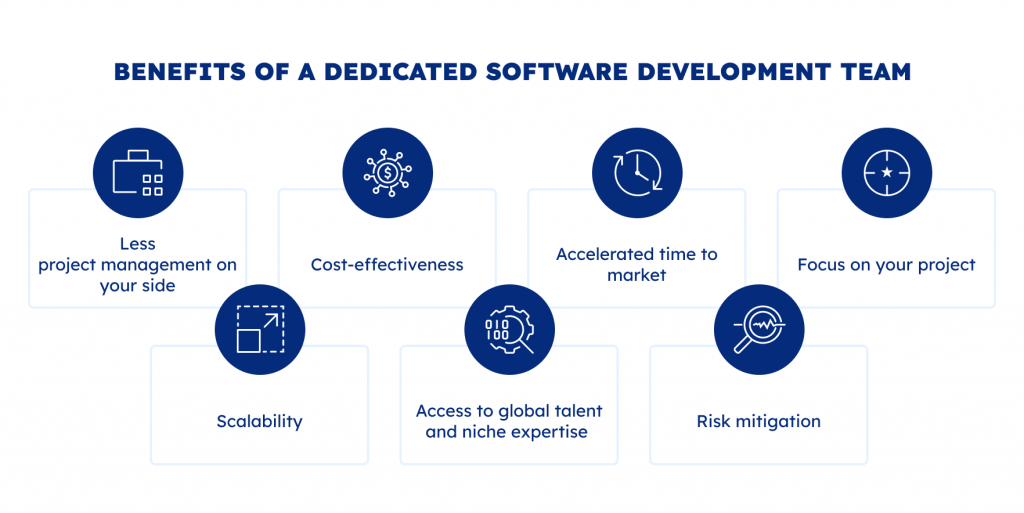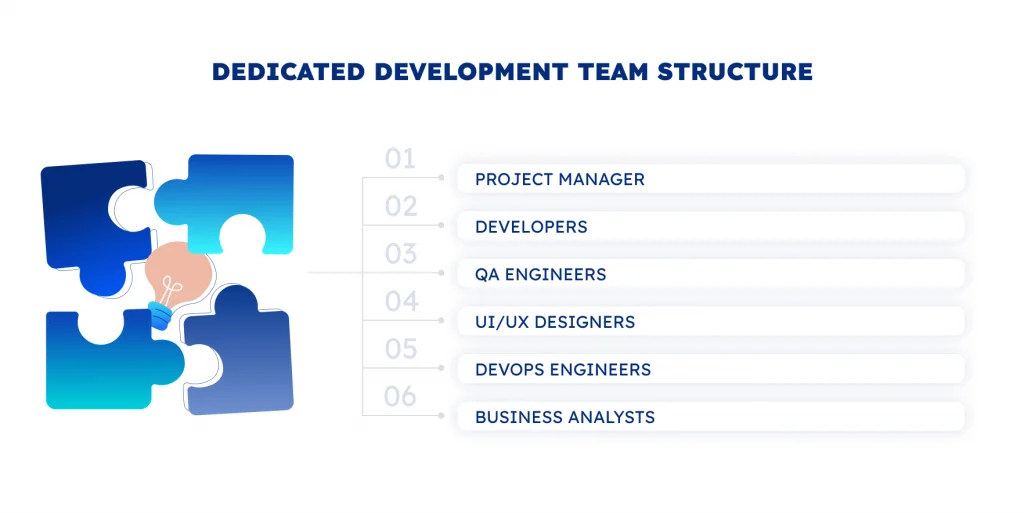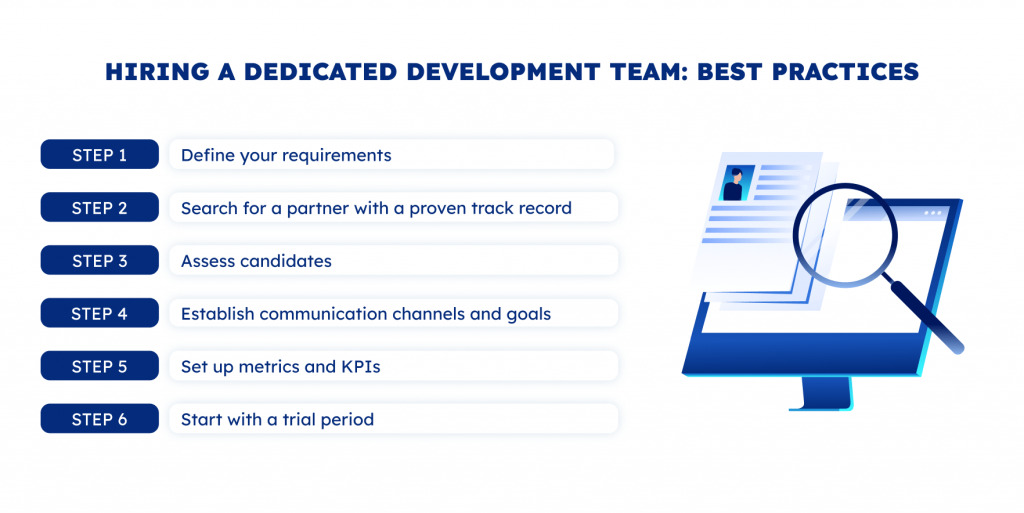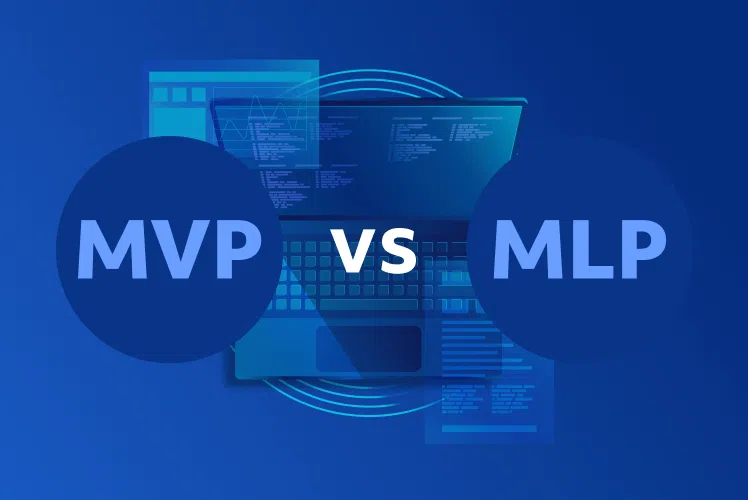Table of Contents
A dedicated development team is a partnership model where the software development team focuses solely on one client’s product. This approach saves lots of time and effort, as it helps companies avoid lengthy hiring processes and quickly upscale their team with the necessary talent.

This article will explain what a dedicated development team is, when you should use it, and how to hire a reliable IT vendor.
What is a dedicated software development team?
A dedicated development team is a model where a vendor provides a group of software professionals who work exclusively on a client’s project. This group may include specialists like project managers, developers, QA engineers, designers, business analysts, etc. Unlike traditional outsourcing, where teams juggle multiple clients, dedicated teams act as your exclusive partner. This usually means the team focuses more closely on your project and internal processes.
Benefits of a dedicated software development team

Let’s consider the key benefits that make this model such a valuable choice for businesses across industries:
Less project management on your side
It can be challenging to manage numerous operational tasks, especially in smaller teams and startups. However, a dedicated team usually consists of experienced members, so you can entrust tasks such as daily check-ins, task prioritization, and tracking deadlines to an experienced project manager.
That means you don’t need to be in every meeting or micromanage every sprint. Instead, you get structured updates, clear timelines, and a single point of contact who keeps everything organized.
Cost-effectiveness
With in-house teams, salaries are not the only thing you pay for. You must also cover recruitment, onboarding, training, office space, hardware, benefits, and sometimes relocation. With dedicated development team services, your company can skip all of that.
Whether you need two developers, a single QA engineer, a UI/UX designer, or a full 10-person product squad, the vendor takes care of hiring, HR, legal matters, and infrastructure. In addition, you can choose your dedicated team in cost-effective regions across the globe to reduce the financial outlays of software development.
Accelerated time to market
Speed matters when developing an MVP, handling customer feedback, or launching new features before your competitors do.
With this engagement model, your company doesn’t need to spend weeks or months hiring and onboarding new staff. Your dedicated team arrives fully equipped and ready to integrate into your environment, adapt to sprint rhythms, and deliver value from day one. This prompt integration speeds up delivery schedules and enhances adaptability to change.
Focus on your project
Unlike traditional outsourcing teams, where developers might work on several projects simultaneously, a dedicated team is entirely at your disposal and committed only to your project. So, your developers don’t switch between different contexts or get distracted by other projects’ pressing needs. That undivided attention usually leads to higher code quality, faster turnaround, and fewer delays.
Scalability
As your project progresses through stages such as building an MVP or scaling to serve enterprise-level customers, you might have different demands in terms of team size, skill sets, and resources. But with a dedicated team, you can easily scale up and down, without having to change contract terms, renegotiate rates, or manage HR logistics.
This benefit appears promising compared to traditional in-house team setups, where adding new developers takes weeks or months between job postings, interviews, onboarding, or training. This, in turn, slows down your development and adjustment of the team structure.
Access to global talent and niche expertise
Finding the right developer for your industry and tech stack can take months, as highly skilled professionals are in short supply, especially if you’re hiring within your local market. Such delays can cost businesses an opportunity.
This is where a team of dedicated developers can handle this pain point, as vendors already have access to a global pool of vetted professionals like senior developers, solution architects, DevOps experts, QA specialists, and more. These individuals often have experience working in domain-specific areas, such as fintech or healthcare. And when it comes to hiring, vendors can match you with experts who fulfill your technical needs as well as your preferences for communication, working style, and time zones.
Risk mitigation
Imagine your backend developer resigning when you’re mid-sprint on a critical release. Finding a replacement for this role might take weeks, which leaves your roadmap stalled and the team overburdened. But if you opt for a dedicated development team model, your vendor takes care of all administrative, legal, and HR-related issues. Even when someone leaves or becomes unavailable, your dedicated team vendor typically has established processes to backfill the role in a short time, often with a specialist familiar with the project or product type. This way, you can concentrate on developing your product while the vendor manages the risks in the background.
Who does a dedicated software development team consist of?

Let’s take a look at the core roles and responsibilities of a dedicated development team:
Project manager
Being a central coordination point between the client and the development team, project managers’ responsibilities include:
- overseeing the project’s day-to-day operations
- ensuring all tasks are completed on time, within scope, and according to agreed quality standards
- managing communications
- handling risks
- prioritizing features
- aligning business goals with business objectives.
In a dedicated team model, project managers take on much of the client’s operational workload, which allows them to stay focused on high-level priorities, like product vision, stakeholder alignment, and go-to-market strategies.
Developers
Developers are the technical pillar of the team. They write, test, and maintain the code for applications and platforms. A dedicated team may include frontend developers, who work on user interfaces, backend developers, who handle server logic, APIs, and databases, and full-stack developers, who do both.
In simple words, developers work with designers, QA specialists, and business analysts to turn technical specifications into software features.
QA engineers
These specialists maintain product performance and reliability. To make software operate seamlessly, they need to detect bugs at the early stages of development before the product reaches end users. QA engineers write test cases, perform manual and automated tests, and ensure software meets quality standards and requirements. As testing helps spot critical defects and outages, you can protect your company and product from damage to your reputation.
UI/UX designers
UI/IX designers work with the interactive and visual aspects of the product. They design intuitive, aesthetically appealing interfaces that deliver a seamless user experience, develop wireframes and prototypes, choose color schemes and icons, and ensure that layouts are responsive, which means they can be used on various devices.
Apart from that, UX designers need to understand user behaviors and needs. That’s why they conduct user research, create detailed user personas, map out user journeys, and even perform usability testing. These activities help determine whether the product meets the target audience’s needs and is easy to navigate.
DevOps engineers
These engineers bridge the efforts of developers who write code with operations that run the system, so that updates and new features can be delivered quickly and without bottlenecks.
Their main job is to automate and manage how software is built, tested, and deployed. They establish continuous integration and delivery (CI/CD) pipelines, set up automated tools that help test and deploy code, and make sure the infrastructure is secure, cost-effective, and scalable.
Moreover, DevOps engineers also take care of your software technical environment. That means they monitor system health, implement logging and alerting mechanisms, and respond instantly to incidents to maintain system stability. In cloud-based environments, they manage resources, containers, and serverless architectures.
In short, DevOps engineers help your team deliver faster, reduce bugs, and keep everything stable for a smooth user experience.
Business analysts
Business analysts help the dev team and designers understand the needs and requirements of project stakeholders. Analysts gather and analyze business requirements, document specifications, prioritize features by their business value, and conduct feasibility assessments. In many cases, they also help perform user acceptance testing, refine the product backlog, and ensure that every technical aspect serves a clear business goal.
With an experienced business analyst in your dedicated software development team, you’re more likely to build software that solves the right problems, stays on budget, and delivers real results for your business and users.
The strategic advantage of a dedicated development team resides in its adaptability. You obtain precisely the expertise and roles necessary when your project demands them. Furthermore, you shape the team’s structure according to your current needs.
Calculate your dedicated development team budget
When should you consider a dedicated development team model?
There are situations in which you should hire a dedicated developers team that can solve various problems. This model is an option to consider in the following cases:
Long-term projects
Consistency becomes critical when you’re building a product that requires ongoing development over many months or years. If you hire a dedicated software development team, the same professionals stay on the project throughout its lifecycle.
Startups and MVPs
Startups often face pressure to build and launch quickly with limited resources. If you work on a minimum viable product and aim to enter the market faster, it will take a lot of time and resources to assemble your in-house team. But a dedicated team gives you immediate access to skilled engineers, designers, and testers, which helps boost development speed and quality.
Lack of in-house expertise
Many companies don’t always have the required technical skills within their internal teams, especially for emerging technologies or complex projects. Hiring full-time engineers can be burdensome and time-consuming, while freelancers tend to lack long-term commitment. In this context, a dedicated team model offers access to a pre-vetted pool of professionals who already have the necessary skills, and you don’t spend resources on onboarding and recruitment.
Projects with ever-changing requirements
In dynamic environments, where startups test new features or a product evolves based on user feedback, requirements shift frequently. In this scenario, a team of dedicated developers easily adapts to new priorities, scales up or down as needed, and adjusts the timelines without revising the entire contract.
How to hire a dedicated development team: best practices

You should approach the recruitment process with a clear plan and realistic expectations, and consider the following steps to select your vendor wisely:
Define your requirements
Before you negotiate with vendors, take the time to define your project’s needs, goals, key features, and timelines. A vendor should discuss these aspects with you and help you create detailed scope documentation and technical requirements. During the process, consider the technologies you plan to use, such as programming languages, platforms, tools, and frameworks. After that, it will be crucial to determine the skill gaps of your current internal team, how many specialists and what roles you need to work on your product. Then, you can set clear timelines and a budget to communicate your requirements to potential partners more effectively.
Search for a partner with a proven track record
Search for vendors who have a proven track record of delivering similar projects. It usually includes case studies, client testimonials, and information about their industry expertise.
To better understand what partner will match your expectations, learn how they recruit talent, assess technical and soft skills, and whether they’re compatible with your time zone and offer flexibility in scheduling meetings.
Assess candidates
Even though your vendor can assemble a team, you should actively participate in the process and assess the candidates’ skills. Ask to review CVs and portfolios, and schedule video interviews with key team members. You can give them short technical tests or coding assignments to check their skills and see how they think in a working scenario.
Hard skills are not the only thing you should pay attention to. Evaluate how well candidates communicate, ask questions, and show interest in your product. A technically strong developer may not be the right fit for your team dynamics if they struggle to collaborate and adapt.
Establish communication channels and goals
As teams work remotely, it’s vital to establish channels for effective communication. That’s why you must agree on how and when to communicate — Slack, Microsoft Teams, email, or other platforms. Define the frequency of meetings, whether they are daily stand-ups or weekly reviews, and clarify your team’s roles and responsibilities, so everyone knows how to present their views and information about a project.
Also, set workflows that align with your preferred methodology, be it Scrum, Kanban, or a hybrid model. The more structure you provide upfront, the easier it will be for your dedicated developers to integrate and deliver faster results.
Set up metrics and KPIs
To track how well your team is performing, establish metrics. Common KPIs include sprint velocity, delivery timelines, number of defects found by QA engineers, deployment frequency, and code review quality.
Start with a trial period
One of the advantages of a dedicated team is flexibility. You don’t have to start a collaboration with a year-long contract immediately. Many vendors allow you to begin with a trial period, perhaps a 4- or 6-week sprint, which helps you evaluate the team’s performance, communication efficiency, and overall fit for the project.
Use this time to monitor how your dedicated team handles challenges, adapts to feedback, and meets deadlines, then decide whether you can proceed with further engagement.
Top red flags to watch out for in a dedicated development team
While this partnership model provides various advantages, it’s essential to pay attention to potential red flags that may arise in future collaborations. Consider these important warning signs:
They offer suspiciously low pricing
Suppose a vendor offers pricing noticeably lower than the industry average. In that case, it may indicate potential hidden issues, such as the use of less experienced talent, overlooked requirements, or hidden extra fees. Since development often comes at a price, you should always request a detailed cost estimate and compare it with other providers.
They lack process transparency
Avoid working with teams that are vague about their development practices, timelines, or how they manage your code. A reliable team should walk you through their workflow, collaboration tools, and delivery expectations. If they’re hesitant to share this information, it may indicate inexperience or a reluctance to be held accountable. Transparency builds trust, and without it, collaboration often suffers.
They have poor communication skills
Even the most skilled developers can struggle if communication breaks down. If the team seems disorganized, slow to respond, or unclear in how they interpret your requirements, you could face major delays and misunderstandings. Strong communication practices—like regular check-ins, clear documentation, and responsiveness—are as important as technical skills when working with a remote team.
They have high turnover rates
Frequent staff changes during a project can lead to inconsistent progress, knowledge loss, and missed deadlines. Before hiring, ask about team stability and how the vendor handles transitions when a team member leaves. If developers keep quitting, it’s usually because something’s broken behind the scenes—and your project will pay for it.
They always agree without question
“Yes” isn’t always a good answer. Be careful if a team agrees to every feature, timeline, and demand. Experienced developers speak up when something doesn’t make sense. They ask questions and propose better solutions. If a team never questions your ideas, suggests better options, and just nods along—even when your deadlines or requests don’t make sense—they’re not focused on building the best product. They want to get you to hire them, so they’ll tell you what you want to hear. Therefore, honest, thoughtful feedback is a sign of professionalism and what leads to great results.
What influences the cost of dedicated development teams?
Here’s a breakdown of the core factors that can influence the rates of dedicated teams:
Location of teams
The location of your potential partner is the thing to consider, as based on their region, the rates can vary widely. Teams based in North America and Western Europe tend to have higher rates due to living costs and local salaries. Meanwhile, Eastern Europe, Latin America, and some parts of Asia can offer access to skilled professionals at more competitive rates.
In this case, the cheapest option doesn’t always mean it’s the best deal. This is because, in addition to rates, things like time zone compatibility, language skills, and cultural alignment also affect your project’s success.
Team composition
The cost also depends on the number of people you need, as larger teams cost more than smaller ones. However, the headcount is not the only factor to consider. The types of specialists you hire matter as well. If we take senior developers, solution architects, DevOps specialists, and AI/machine learning experts in AI, they typically command higher rates.
Project duration
Long-term contracts of over six months often provide discounted rates, as they ensure financial stability and reduce administrative workload. In contrast, short-term contracts have higher hourly rates due to the temporary nature of work. So, longer collaborations will be more beneficial, as you get better rates, and your team has enough time to get to know your product and business goals.
Product complexity
The more complex your project is, the more resources it requires. For instance, a basic content management platform with standard features will be cheaper to build than a SaaS product with real-time data processing, multi-language support, and third-party integrations.
Complexity increases costs in multiple ways: more development hours, more specialists involved, and more time spent on planning. It may also require custom infrastructure, tighter security measures, and compliance with specific regulations, which further contribute to the total price.
Management and communication
Some vendors offer all-inclusive services where project management, sprint planning, QA processes, and reporting are built into their rates. Others may treat these activities as add-ons and separate options, so it’s better to clarify early whether your rate covers a dedicated project manager, QA engineers, and others.
Ensuring communication channels, providing regular updates, and streamlining workflows also come at a cost but save budget in the long run as they help avoid misunderstandings, scope creep, and delivery delays.
Legal and administrative costs
Depending on your engagement terms with a vendor, you may need to account for legal expenses such as handling contracts, signing NDAs, covering licensing fees (for software like Jira, Stack, GitHub, or Figma), and managing intellectual property registrations. If your project involves sensitive data, you may need to budget for compliance with GDPR or HIPAA. While these expenses may be a small portion of the overall budget, they are still essential to safeguard your business and should not be overlooked, especially at the early stages.
Challenges that dedicated developer teams might face
Communication barriers
As dedicated developers work from various locations and time zones, it can lead to miscommunication, delays, and a lack of real-time collaboration. That’s why you should choose sustainable communication methods (Zoom, Microsoft Teams, Slack, etc.), schedule regular meetings during overlapping work hours, and maintain documentation, such as project requirements, technical specifications, sprint logs, etc. This will help keep your team aligned even across time zones.
Scope creep
Clients often request additional features, but the development process has already begun. In this case, changes to the project scope have to be made, which results in increased costs, missed deadlines, and greater pressure on team capacity.
To solve this problem, project managers must create the project scope and set boundaries with the client from the beginning. They should discuss any potential changes to the scope at the early stages, so that the development team has more time to adjust their timelines.
Technical debt
Developers may take shortcuts like writing messy code, skipping the refactoring of outdated code, or not testing thoroughly. At first glance, these shortcuts save time, but can result in bigger issues later. Technical debt slows the development process, creates bugs, and makes it much harder to add new features.
To avoid this, teams should start writing clean, well-organized code from the start. That’s why regular code reviews, automated testing, and scheduled refactoring are go-to ways to keep technical debt under control.
Expert Opinion
We all prefer having “our own” trusted hairdresser, dentist, car mechanic, or cleaner. So why should building software be any different?
That’s exactly why most of my clients eventually choose the dedicated team model. Explaining the same things over and over again, re-aligning expectations, and re-making decisions drains both time and energy. That’s what a committed team is for.
A dedicated team means you have a Project Manager who acts on your behalf, and developers who know your product like the back of their hand. And in today’s world, where we can tap into top-tier talent anywhere on the planet, why settle for less? I always encourage my clients to take advantage of this and build the best possible team for their product or MVP — one that feels like their own, because it is.
Final thoughts
Companies can turn to a vendor that offers a dedicated software development team model to address such challenges as delayed hiring cycles, talent gaps, rising development costs, and inconsistent delivery. In return, they get a team of dedicated and skilled professionals fully committed to their project that provides the structure and discipline of an in-house team combined with the flexibility of an outsourced team.


Comments